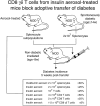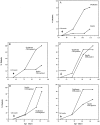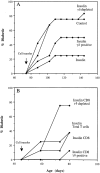Aerosol insulin induces regulatory CD8 gamma delta T cells that prevent murine insulin-dependent diabetes
- PMID: 8976172
- PMCID: PMC2196363
- DOI: 10.1084/jem.184.6.2167
Aerosol insulin induces regulatory CD8 gamma delta T cells that prevent murine insulin-dependent diabetes
Abstract
Cellular immune hyporesponsiveness can be induced by the presentation of soluble protein antigens to mucosal surfaces. Most studies of mucosa-mediated tolerance have used the oral route of antigen delivery and few have examined autoantigens in natural models of autoimmune disease. Insulin is an autoantigen in humans and nonobese diabetic (NOD) mice with insulin-dependent diabetes mellitus (IDDM). When we administered insulin aerosol to NOD mice after the onset of subclinical disease, pancreatic islet pathology and diabetes incidence were both significantly reduced. Insulin-treated mice had increased circulating antibodies to insulin, absent splenocyte proliferation to the major epitope, insulin B chain amino acids 9-23, which was associated with increased IL-4 and particularly IL-10 secretion, and reduced proliferation to glutamic acid decarboxylase, another islet autoantigen. The ability of splenocytes from insulin-treated mice to suppress the adoptive transfer of diabetes to nondiabetic mice by T cells of diabetic mice was shown to be caused by small numbers of CD8 gamma delta T cells. These findings reveal a novel mechanism for suppressing cell-mediated autoimmune disease. Induction of regulatory CD8 gamma delta T cells by aerosol insulin is a therapeutic strategy with implications for the prevention of human IDDM.
Figures



Similar articles
-
Oral administration of cholera toxin B-insulin conjugates protects NOD mice from autoimmune diabetes by inducing CD4+ regulatory T-cells.Diabetes. 1999 Nov;48(11):2150-6. doi: 10.2337/diabetes.48.11.2150. Diabetes. 1999. PMID: 10535448
-
Gamma delta T cells as mediators of mucosal tolerance: the autoimmune diabetes model.Immunol Rev. 2000 Feb;173:109-19. doi: 10.1034/j.1600-065x.2000.917303.x. Immunol Rev. 2000. PMID: 10719672 Review.
-
Plasmid DNAs encoding insulin and glutamic acid decarboxylase 65 have distinct effects on the progression of autoimmune diabetes in nonobese diabetic mice.J Immunol. 2001 Jul 1;167(1):586-92. doi: 10.4049/jimmunol.167.1.586. J Immunol. 2001. PMID: 11418698
-
alpha/beta-T cell receptor (TCR)+CD4-CD8- (NKT) thymocytes prevent insulin-dependent diabetes mellitus in nonobese diabetic (NOD)/Lt mice by the influence of interleukin (IL)-4 and/or IL-10.J Exp Med. 1998 Apr 6;187(7):1047-56. doi: 10.1084/jem.187.7.1047. J Exp Med. 1998. PMID: 9529321 Free PMC article.
-
Insulin dependent diabetes mellitus in the non-obese diabetic mouse: a disease mediated by T cell anergy?Life Sci. 1994;55(15):1163-77. doi: 10.1016/0024-3205(94)00655-5. Life Sci. 1994. PMID: 7934613 Review.
Cited by
-
Trials in type 1 diabetes: Antigen-specific therapies.Clin Immunol. 2013 Dec;149(3):345-55. doi: 10.1016/j.clim.2013.02.002. Epub 2013 Feb 15. Clin Immunol. 2013. PMID: 23490422 Free PMC article. Review.
-
γδ T cells: origin and fate, subsets, diseases and immunotherapy.Signal Transduct Target Ther. 2023 Nov 22;8(1):434. doi: 10.1038/s41392-023-01653-8. Signal Transduct Target Ther. 2023. PMID: 37989744 Free PMC article. Review.
-
The natural killer T lymphocyte: a player in the complex regulation of autoimmune diabetes in non-obese diabetic mice.Clin Exp Immunol. 2006 Feb;143(2):194-202. doi: 10.1111/j.1365-2249.2005.02942.x. Clin Exp Immunol. 2006. PMID: 16412042 Free PMC article. Review.
-
gammadelta T lymphocytes-selectable cells within the innate system?J Clin Immunol. 2007 Mar;27(2):133-44. doi: 10.1007/s10875-007-9077-z. Epub 2007 Feb 14. J Clin Immunol. 2007. PMID: 17333410 Review.
-
Immune therapy for type 1 diabetes mellitus-what is unique about anti-CD3 antibodies?Nat Rev Endocrinol. 2010 Mar;6(3):149-57. doi: 10.1038/nrendo.2009.275. Nat Rev Endocrinol. 2010. PMID: 20173776 Review.
References
-
- Honeyman MC, Harrison LC. The immunologic insult in type 1 diabetes. Springer Semin Immunopathol. 1993;14:253–274. - PubMed
-
- Bach J-F. Insulin-dependent diabetes mellitus as an autoimmune disease. Endocrine Rev. 1994;15:516–542. - PubMed
-
- Mordes JP, Desemone J, Rossini AA. The BB rat. Diab Metab Rev. 1987;3:725–750. - PubMed
-
- Kikutani H, Makino S. The murine autoimmune diabetes model: NOD and related strains. Adv Immunol. 1992;51:285–322. - PubMed
-
- Adorini L, Guery JC, Trembleau S. Approaches towards peptide-based immunotherapy of autoimmune diseases. Springer Semin Immunopathol. 1992;14:187–199. - PubMed
Publication types
MeSH terms
Substances
LinkOut - more resources
Full Text Sources
Other Literature Sources
Medical
Research Materials

